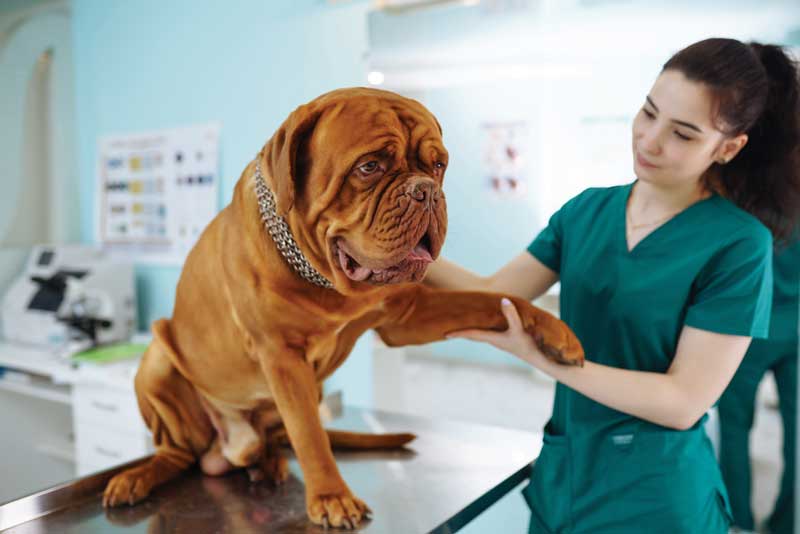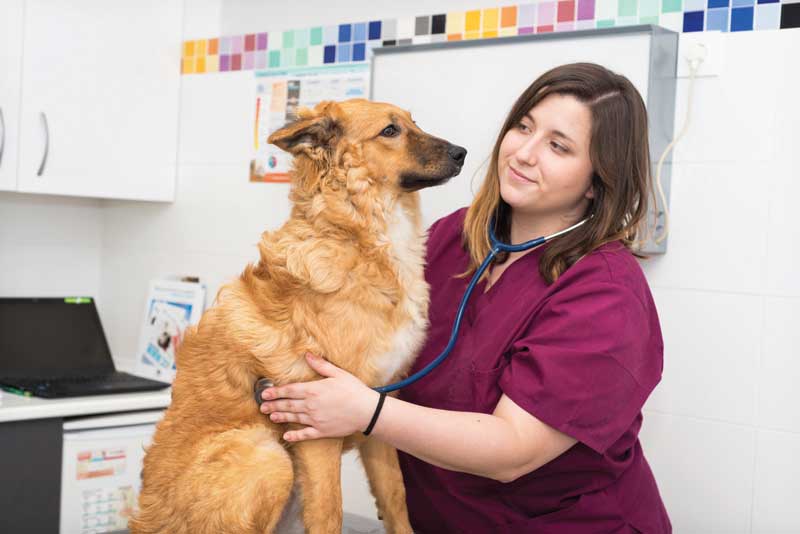
Cancer is the leading cause of death in older dogs,1 yet there is no consensus among veterinarians regarding cancer screening or diagnostic guidelines.
Liquid biopsy has emerged as a powerful, multifaceted tool for cancer detection and multi-cancer early detection (MCED) tests are now commercially available for dogs. Before we can broadly incorporate these tests into our clinical practice, we need to understand how they work, consider the evidence behind them, and demonstrate that using them reduces cancer-related deaths, predicts prognosis, or prolongs dogs’ lives with cancer to a clinically significant degree.
Defining terms
Liquid biopsy is a test that detects biomarkers of disease in blood or bodily fluids. These biomarkers may include cell-free DNA, RNA, nucleosomes, exosomes, or proteins.2
Multi-cancer early detection (MCED) tests utilize liquid biopsy to screen simultaneously for multiple different types of cancer in a single blood sample. Some MCED tests can predict which organ the tumor originated from, but others broadly detect the presence of multiple tumor types with no indication as to which cancer is present or where.
Looking at evidence
There are a few liquid biopsy tests approved by the U.S. Food and Drug Administration (FDA), for specific cancer types, with specific biomarkers known to predict prognosis or response to treatment in people. However, despite rapid commercial development, no MCED tests are FDA-approved yet to our knowledge. Prior to widespread use by doctors, large-scale randomized controlled trials must be performed to understand the clinical benefits and harms of using MCED tests for cancer screening and to assess their impact on cancer-related mortality.3

There is no outside regulatory body playing a role in commercialization of veterinary diagnostics, and as a result, MCED tests are already available to veterinarians.
How do these work?
One technique MCED tests use is next-generation sequencing (NGS) to analyze cell-free DNA from a dog’s blood sample and look for genomic variants associated with cancer. These tests are not currently able to determine the source of the signal among the multiple different cancers for which they test.4
Another technique is detection of plasma nucleosomes, which are fragments of chromosomes released into the blood with cell death. Plasma nucleosome concentrations are elevated with some cancers but are not specific for cancer.
How well do they detect cancer?
We are beginning to see robust clinical validation studies published MCED tests,4-7 but we need to be careful generalizing these results. In one clinical validation study with 1,100 dogs, the overall sensitivity of one MCED test was 54.7 percent (95 percent confidence interval (CI): 49.3-60 percent), and the specificity was 98.5 percent (95 percent CI: 97-99.3 percent).4 This means dogs with cancer tested positive ~50 percent of the time and 98.5 percent of dogs without cancer tested negative. When a different test was validated in 662 dogs, comparable overall sensitivity of 49.8 percent and specificity of 97 percent were demonstrated.5
Studies on diagnostic test accuracy are highly susceptible to biases, including type of patient sampling (spectrum bias)8 and disease prevalence.9 Case-control study design, which all4-5,7 but one6 of these clinical validation studies used, has been shown to overestimate the diagnostic test accuracy.8 Therefore, these reported parameters may be overestimated when applied to different populations.
When used for cancer screening in a subset of 286 asymptomatic dogs, the observed positive predictive value (PPV) of one MCED test was 75 percent (95 percent CI: 54.8-88.6 percent), meaning 75 percent of dogs with a positive result were subsequently diagnosed with cancer. The PPV was much higher (97.7 percent, 95 percent CI: 86.5-99.9 percent) when the test was used as a companion diagnostic in 127 dogs with clinical signs and suspicion of cancer.6 The relative observed negative predictive value (NPV) in the screening population was 94.2 percent (95 percent CI: 90.4-96.6 percent), with up to 10 percent of dogs with a negative result being subsequently diagnosed with cancer at a median time of 68 days after the negative test (range 0-195 days). However, in the companion diagnostic population, the relative observed NPV was 67.5 percent (95 percent CI: 56.2-77.1 percent), meaning cancer was ultimately diagnosed in ~33 percent of dogs with a negative result.6 Therefore, interpretation of results greatly hinges on the clinical intent and the population in which the test is used.
Conditions that interfere with these tests
Regarding the nucleosome-based technology, plasma nucleosomes are increased with some cancers, but are also released during white blood cell activation and normal cell death and therefore increased with some infectious and inflammatory conditions. This has been documented in sepsis, trauma, and immune-mediated hemolytic anemia,5 but it is possible other similar diseases may also result in false positives. Currently, there is no clear understanding of how much liquid biopsy tests are impacted by tumor heterogeneity or confounding patient variables, such as age, breed, or body weight.
How early do these tests detect cancer and affect mortality?
These are still unknown. With current MCED tests, the detection rate increases as a function of tumor size and cancer stage. With larger, more widespread, rapidly proliferating cancer, more cell-free DNA is likely to be circulating and, therefore, detectable.
With one test, the detection rate increased from 19.6 percent, when tumors were localized/<5 cm, to 87.5 percent, when cancers were disseminated, metastatic, and/or >5 cm4 and similar results were seen with another test.5 Therefore, if these tests are marketed for screening, we need to be cognizant of the greatly reduced detection of early-stage disease.
For an MCED test to be successful, it would need to detect cancer early enough it improves outcomes with our available cancer treatments. For some cancers, we do not have any effective treatments. Early detection is susceptible to lead-time bias where patients appear to live longer because they were diagnosed earlier when they were asymptomatic, but in reality, their disease course and survival are unchanged.
How often should these tests be performed?
Cancers grow and spread at variable rates. If you wait too long between tests, you might miss early detection of some cancers, but if you test too often, you could be wasting resources (time, money, personnel) and creating an unnecessary source of psychological stress for the pet, owner, and veterinary team.
What should you do if you get a positive result?
Liquid biopsy cannot replace our standard cancer diagnostic tests, but it can complement them. The first step after receiving a positive MCED result is to perform diagnostics to look for cancer. Typically, this includes a physical exam, complete blood count, chemistry panel, urinalysis, and imaging such as thoracic radiographs and abdominal ultrasound or CT scan.
Tissue sampling (aspirate or biopsy) must still be performed for definitive diagnosis. If a mass is found, there is no current way to prove it is the source of the positive liquid biopsy result (i.e. incidental liver or splenic nodules).
Additionally, if the patient is not showing any clinical signs of disease, we do not know the benefit of additional invasive tests or treatments, which are not without risk.
Telling an owner their pet has cancer, when they really do not, could be very harmful to both the owner and the pet. If you have a positive MCED result but do not identify any source on exam, imaging, or bloodwork, how far do you go before considering it a false positive? How often should you repeat diagnostics moving forward to see if cancer develops? Also, we need to be cognizant that even if cancer is not found, a positive result could bias future care for that patient. Will owners be less willing to treat treatable conditions as they arise if they are concerned their pet has cancer hiding somewhere that we cannot yet identify?
What should you do if you get a negative result?
If you are using the MCED test in screening an asymptomatic dog, the optimal interval for repeating it is unknown. If you are concerned the pet has cancer in the face of a negative MCED result, you should still perform your routine diagnostic workup. Interpretation of results must be done in conjunction with the clinical picture and other diagnostics. Reassuring an owner their pet does not have cancer when it actually does (false negative) or knowing it could develop cancer at any time after the test could be equally harmful.
Conclusion
Liquid biopsy is an innovative technology with great potential, and we should be excited by the prospect of incorporating it into our practice. However, we must consider patient selection and interpretation of results, especially in the setting of MCED and cancer screening.
How will it change our recommendations and the outcome for that particular patient? What will you do if you get a positive result? A negative result? Is the client prepared to take those next steps?
Screening tests and guidelines exist in human medicine for breast, cervical, colorectal, prostate, and lung cancer, because over time organ-specific screening has been shown to save lives. Despite the improvement with early detection of those few cancer types, many human cancer-related deaths are still caused by cancers for which screening has shown no benefit.
Before widespread recommendations can be made for our veterinary patients, we need to better understand cancer risk assessment and the impact of screening on outcomes in order to justify the cost and potential anxiety of cancer screening to pet owners and ourselves.
To address these knowledge gaps, we must work together—general practitioners, oncologists, and industry—to determine if or how the incorporation of these new tests into our diagnostic toolbox helps or harms patients. Additional research is needed to determine the diagnostic accuracy of these tests in larger cohort-selected populations. To assess the benefit of cancer screening on survival, more longitudinal studies in asymptomatic populations with clinical follow-up must be done.
We need to be open-minded and adaptable as more data becomes available. We are moving toward an exciting paradigm shift in the way cancer is diagnosed and managed, but we need to remember these tools are only valuable if we can harness them to improve patient outcomes.
Skylar Sylvester, DVM, DACVIM (Oncology), is an assistant clinical professor at Cornell University College of Veterinary Medicine. Dr. Sylvester is a member of the Evidence-Based Veterinary Medical Association (EBVMA), with different members contributing to this column. While all articles are reviewed for content, the opinions and conclusions of the author(s) do not necessarily reflect the views of the EBVMA or Veterinary Practice News. For information about the association or to join, visit https://www.ebvma.org.
References
- Fleming JM, Creevy KE, Promislow DEL. Mortality in North American Dogs from 1984 to 2004: An Investigation into Age‐, Size‐, and Breed‐Related Causes of Death. J Vet Intern Med. 2011;25: 187–198.
- Nikanjam M, Kato S, Kurzrock R. Liquid biopsy: current technology and clinical applications. J Hematol Oncol 2022;15:131.
- Minasian LM, et al. Study design considerations for trials to evaluate multicancer early detection assays for clinical utility. J Natl Cancer Inst 2023;115(3):250-257.
- Flory A, et al. Clinical validation of a next-generation sequencing-based multi-cancer early detection “liquid biopsy” blood test in over 1,000 dogs using an independent testing set: The CANcer Detection in Dogs (CANDiD) study. PLoS One. 2022;17(4):e0266623.
- Wilson-Robles HM, et al. Evaluation of plasma nucleosome concentrations in dogs with a variety of common cancers and in healthy dogs. BMC Vet Res. 2022;18(1):329.
- O’Kell AL, et al. Clinical experience with next-generation sequencing-based liquid biopsy testing for cancer detection in dogs: a review of 1,500 consecutive clinical cases. J Am Vet Med Assoc. 2023;261(6):827-836.
- Wilson-Robles H, et al. Evaluation of nucleosome concentrations in healthy dogs and dogs with cancer. PLoS ONE. 2020;15(8):e0236228.
- Rutjes AW, et al. Evidence of bias and variation in diagnostic accuracy studies. CMAJ. 2006;174(4):469-76.
- Leeflang MM, et al. Variation of a test’s sensitivity and specificity with disease prevalence. CMAJ. 2013;185(11):E537-44.
